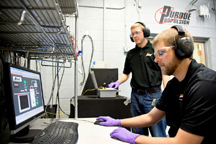Research aims to reduce security threats from explosives
September 30, 2013
 |
|
Purdue doctoral student David Kittell, at left, and graduate student Peter Renslow perform an experiment to study homemade explosives as part of a national effort to protect against terrorist attacks. Purdue researchers are participating in the Awareness and Localization of Explosives-Related Threats center (ALERT). (Purdue University photo/Andrew Hancock) |
WEST LAFAYETTE, Ind. - Purdue University researchers are working on ways to detect explosives and neutralize their impact as part of a U.S. Department of Homeland Security center led by Northeastern and Rhode Island universities.
The researchers are participating in the Awareness and Localization of Explosives-Related Threats center (ALERT).
"The work we do aims to improve screening for explosives at airports, seaports and other public venues like football arenas and the civilian infrastructure," said Stephen Beaudoin, a professor of chemical engineering and director of graduate admissions in the School of Chemical Engineering.
The Purdue team also is led by Steven Son, a professor of mechanical engineering, and Charles Bouman, Purdue's Showalter Professor of Electrical and Computer Engineering and Biomedical Engineering.
Funding recently was renewed to ALERT, a Department of Homeland Security Center of Excellence. A consortium of universities and national laboratories, ALERT is one of 12 such centers in the nation. Its second phase will be launched during a ceremony on Oct. 22 at Northeastern.
Researchers are working to develop portable detectors as well as larger systems to scan for explosives. Some technologies will analyze the spectrum of light shining through vaporized samples; others will analyze solid residues.
"You might, for example, analyze a fingerprint to tell whether a person had been handling explosives," Beaudoin said.
Bouman and Son have been working in the center for about four years, while Beaudoin recently joined the team.
Beaudoin's research focuses on detecting traces of explosives. Son's research has focused on blast mitigation using water sprays and barriers and more recently on characterizing homemade explosives so that their threat can be better assessed. Bouman focuses on using CT scanners to detect and identify explosives in luggage, cargo cases and other applications.
"As part of our work for ALERT, we are creating a new generation of algorithms for CT reconstruction in airport security scanners," Bouman said. "These algorithms have the potential to both increase the safety of travel and also reduce inconvenience and cost to the public."
Researchers are improving the performance of CT scanners and other devices using a system of models to extract specific information from huge collections of data and then reconstructing images like a jigsaw puzzle. The new approach is called model-based iterative reconstruction, or MBIR.
Traditionally, imaging sensors and software are designed to detect and measure a particular property. The new approach does the inverse, collecting huge quantities of data and later culling specific information from this pool of information using specialized models and algorithms.
MBIR could bring more affordable CT scanners for airport screening. In conventional scanners, an X-ray source rotates at high speed around a chamber, capturing cross section images of luggage placed inside the chamber. However, MBIR could enable the machines to be simplified by eliminating the need for the rotating mechanism.
Son's research for ALERT focuses specifically on the types of explosives most likely to be used by terrorists.
"We've concentrated on the small-scale explosive characterization of homemade explosives typically made by terrorists," he said. "The need to characterize explosives that could be used in threats has been increasing due to the variety of constituent materials used and relatively low costs that allow terrorist to obtain and use them."
He leads work to perform experiments and simulations using a computer code developed by Sandia National Laboratories.
"The final goal of this work is to demonstrate that the calibrated model obtained from the small-scale experiment is able to predict the results of large-scale experiments," he said.
Researchers will work to characterize a wider variety of explosives, develop high-resolution data analysis techniques and compare experimental data to the simulations.
The research also will include work by Purdue postdoctoral associates and students. It is based at the Maurice J. Zucrow Laboratories and the Forney Hall of Chemical Engineering.
More information about the center is available at http://www.northeastern.edu/alert/
Writer: Emil Venere, (765) 494-4709, venere@purdue.edu
Sources: Stephen Beaudoin, 765-494-7944, sbeaudoi@purdue.edu
Charles Bouman, 765-494-0340, bouman@purdue.edu
Steven Son, 765-494-0539, sson@purdue.edu
Related website:

